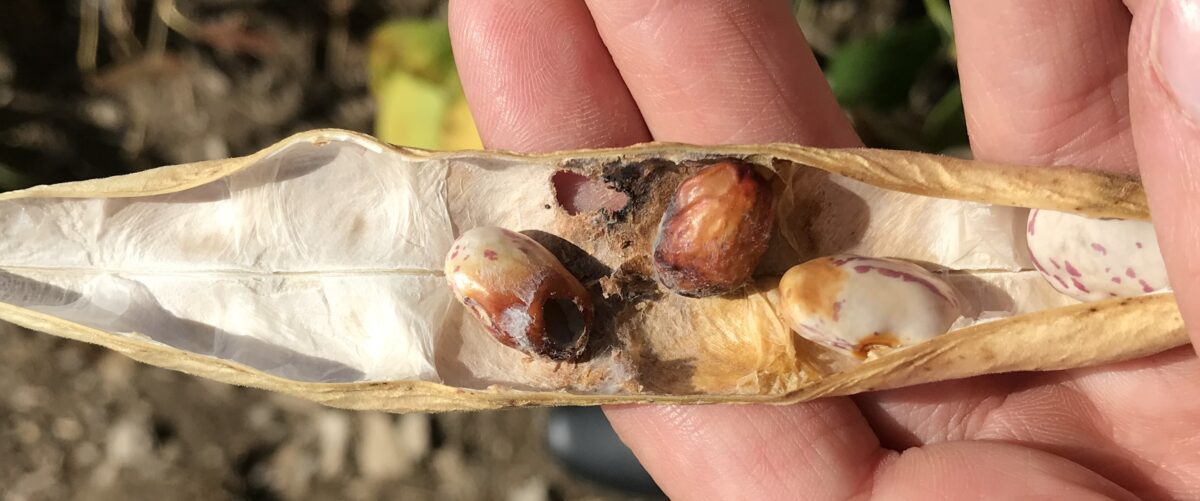This article is intended to briefly answer questions surrounding WBC in Ontario dry beans. More comprehensive information can be found in the OMAFRA Infosheet on WBC or in other WBC articles on this website. You can also check FieldCropNews.com for timely updates or follow @TraceyBaute and @megnmoran on Twitter.
Where are they in Ontario?
Western Bean Cutworm (WBC) are active in most field crop-producing counties in Ontario; the Ontario trapping network has not yet had reports of WBC or traps in Nipissing District, Parry Sound, Manitoulin, or areas further north. WBC are a pest of dry beans, field corn and sweet corn.
When do they arrive?
WBC moths begin flying in Ontario in early June. Some WBC overwinter in lighter soils in Ontario and emerge in July. The period during which the most moths are flying is a critical stage in monitoring the pest and is referred to as “peak flight”. Peak flight occurs at different times in different regions, but on average occurs the last week of July or beginning of August. Peak flight may be affected by the weather conditions.
When do they start feeding?
Eggs can be laid anytime from mid-June to the end of August. Peak flight also loosely defines the peak egg laying period for a given field. Eggs hatch 5-7 days after they are laid. The tiny larvae eat their egg shells and feed briefly on dry bean leaves, then begin feeding on the surface of pods or tunneling into pods as they grow larger. They primarily feed at night and spend the day on the soil surface. They will continue to feed until harvest time. Feeding holes in pods will be larger as the larvae grow larger.
How do I decide to spray insecticide? When do I spray?
There are no established action thresholds for WBC based on the number of moths caught in traps or the extent of pod feeding damage.
Scouting for WBC in dry beans is very difficult. Eggs are laid on leaves, often the underside, deep within the canopy. Even with diligent and frequent scouting you may not find eggs or larvae.
Spraying should only occur after peak flight has passed, eggs have hatched, and larvae are feeding on pods. Pod feeding is expected to begin 10 to 20 days after peak flight. It is therefore extremely helpful to have WBC traps on the field to know when peak flight has occurred and time insecticide application for approximately 14 to 20 days after peak flight.
Insecticide spraying should only occur if ALL the following criteria are met:
- There are pods on the plant. Coating pods with insecticide is the only way to intercept larvae with insecticide.
- More than 150 moths total have been caught in WBC traps on the field, i.e. it is not a fringe area for WBC. (This is not an action threshold, do not spray the day after 150 moths are caught!)
- Peak flight has passed, weekly trap captures are declining
- You can find pod feeding damage.
- The beans will not be harvested within the pre-harvest interval stipulated on the insecticide label.
Feeding on a pod typically causes loss of individual beans and compromises the quality of intact beans in the pod. Holes in pods allow diseases to enter and expose beans to the air which will discolour some types such as cranberry beans. Larger seeded beans are generally viewed as more at risk to WBC damage than smaller seeded beans. Generally speaking, it is recommended to apply an insecticide if entry holes in pods are observed prior to R6 (50% of pods with fully developed seed). Producers are encouraged to scout for pod feeding and consider the percent of damaged pods in evaluating whether to spray.
At this time Coragen, Matador and Voliam Xpress are registered for WBC control in dry beans. Consult the OMAFRA Field Crop Protection Guide for more information on insecticides. Traps can be ordered from Solida in Quebec.
